(Press-News.org) Melanoma is by far the deadliest form of skin cancer, killing more than 7,000 people in the United States in 2019 alone. Early detection of the disease dramatically reduces the risk of death and the costs of treatment, but widespread melanoma screening is not currently feasible. There are about 12,000 practicing dermatologists in the US, and they would each need to see 27,416 patients per year to screen the entire population for suspicious pigmented lesions (SPLs) that can indicate cancer.
Computer-aided diagnosis (CAD) systems have been developed in recent years to try to solve this problem by analyzing images of skin lesions and automatically identifying SPLs, but so far have failed to meaningfully impact melanoma diagnosis. These CAD algorithms are trained to evaluate each skin lesion individually for suspicious features, but dermatologists compare multiple lesions from an individual patient to determine whether they are cancerous - a method commonly called the "ugly duckling" criteria. No CAD systems in dermatology, to date, have been designed to replicate this diagnosis process.
Now, that oversight has been corrected thanks to a new CAD system for skin lesions based on convolutional deep neural networks (CDNNs) developed by researchers at the Wyss Institute for Biologically Inspired Engineering at Harvard University and the Massachusetts Institute of Technology (MIT). The new system successfully distinguished SPLs from non-suspicious lesions in photos of patients' skin with ~90% accuracy, and for the first time established an "ugly duckling" metric capable of matching the consensus of three dermatologists 88% of the time.
"We essentially provide a well-defined mathematical proxy for the deep intuition a dermatologist relies on when determining whether a skin lesion is suspicious enough to warrant closer examination," said the study's first author Luis Soenksen, Ph.D., a Postdoctoral Fellow at the Wyss Institute who is also a Venture Builder at MIT. "This innovation allows photos of patients' skin to be quickly analyzed to identify lesions that should be evaluated by a dermatologist, allowing effective screening for melanoma at the population level."
The technology is described in Science Translational Medicine, and the CDNN's source code is openly available on GitHub.
Bringing ugly ducklings into focus
Melanoma is personal for Soenksen, who has watched several close friends and family members suffer from the disease. "It amazed me that people can die from melanoma simply because primary care doctors and patients currently don't have the tools to find the "odd" ones efficiently. I decided to take on that problem by leveraging many of the techniques I learned from my work in artificial intelligence at the Wyss and MIT," he said.
Soenksen and his collaborators discovered that all the existing CAD systems created for identifying SPLs only analyzed lesions individually, completely omitting the ugly duckling criteria that dermatologists use to compare several of a patient's moles during an exam. So they decided to build their own.
To ensure that their system could be used by people without specialized dermatology training, the team created a database of more than 33,000 "wide field" images of patients' skin that included backgrounds and other non-skin objects, so that the CDNN would be able to use photos taken from consumer-grade cameras for diagnosis. The images contained both SPLs and non-suspicious skin lesions that were labeled and confirmed by a consensus of three board-certified dermatologists. After training on the database and subsequent refinement and testing, the system was able to distinguish between suspicious from non-suspicious lesions with 90.3% sensitivity and 89.9% specificity, improving upon previously published systems.
But this baseline system was still analyzing the features of individual lesions, rather than features across multiple lesions as dermatologists do. To add the ugly duckling criteria into their model, the team used the extracted features in a secondary stage to create a 3D "map" of all of the lesions in a given image, and calculated how far away from "typical" each lesion's features were. The more "odd" a given lesion was compared to the others in an image, the further away it was from the center of the 3D space. This distance is the first quantifiable definition of the ugly duckling criteria, and serves as a gateway to leveraging deep learning networks to overcome the challenging and time-consuming task of identifying and scrutinizing the differences between all the pigmented lesions in a single patient.
Deep learning vs. dermatologists
Their DCNN still had to pass one final test: performing as well as living, breathing dermatologists at the task of identifying SPLs from images of patients' skin. Three dermatologists examined 135 wide-field photos from 68 patients, and assigned each lesion an "oddness" score that indicated how concerning it looked. The same images were analyzed and scored by the algorithm. When the assessments were compared, the researchers found that the algorithm agreed with the dermatologists' consensus 88% of the time, and with the individual dermatologists 86% of the time.
"This high level of consensus between artificial intelligence and human clinicians is an important advance in this field, because dermatologists' agreement with each other is typically very high, around 90%," said co-author Jim Collins, Ph.D., a Core Faculty member of the Wyss Institute and co-leader of its Predictive Bioanalytics Initiative who is also the Termeer Professor of Medical Engineering and Science at MIT. "Essentially, we've been able to achieve dermatologist-level accuracy in diagnosing potential skin cancer lesions from images that can be taken by anybody with a smartphone, which opens up huge potential for finding and treating melanoma earlier."
Recognizing that such a technology should be made available to as many people as possible for maximum benefit, the team has made their algorithm open-source on GitHub. They hope to partner with medical centers to launch clinical trials further demonstrating their system's efficacy, and with industry to turn it into a product that could be used by primary care providers around the world. They also recognize that in order to be universally helpful, their algorithm needs to be able to function equally well across the full spectrum of human skin tones, which they plan to incorporate into future development.
"Allowing our scientists to purse their passions and visions is key to the success of the Wyss Institute, and it's wonderful to see this advance that can impact all of us in such a meaningful way emerge from a collaboration with our newly formed Predictive Bioanalytics Initiative," said Wyss Founding Director Don Ingber, M.D., Ph.D., who is also the Judah Folkman Professor of Vascular Biology at Harvard Medical School and Boston Children's Hospital, and Professor of Bioengineering at the Harvard John A. Paulson School of Engineering and Applied Sciences.
INFORMATION:
Additional authors of the paper include Regina Barzilay, Martha L. Gray, Timothy Kassis, Susan T. Conover, Berta Marti-Fuster, Judith S. Birkenfeld, Jason Tucker-Schwartz, and Asif Naseem from MIT, Robert R. Stavert from the Beth Israel Deaconess Medical Center, Caroline C. Kim from Tufts Medical Center, Maryanne M. Senna from Massachusetts General Hospital, and José Avilés-Izquierdo from Hospital General Universitario Gregorio Marañón.
This research was supported by the Abdul Latif Jameel Clinic for Machine Learning in Health, the Consejería de Educación, Juventud y Deportes de la Comunidad de Madrid through the
Madrid-MIT M+Visión Consortium and the People Programme of the European Union's Seventh Framework Programme, the Mexico CONACyT grant 342369/40897, and the US DOE training grant DE-SC0008430.
In a study led by National Institutes of Health (NIH) researchers, scientists found that five genes may play a critical role in determining whether a person will suffer from Lewy body dementia, a devastating disorder that riddles the brain with clumps of abnormal protein deposits called Lewy bodies. Lewy bodies are also a hallmark of Parkinson's disease. The results, published in Nature Genetics, not only supported the disease's ties to Parkinson's disease but also suggested that people who have Lewy body dementia may share similar genetic profiles to those who have Alzheimer's disease.
"Lewy body dementia is a devastating brain disorder for which we have no effective treatments. Patients often appear to suffer the worst of both Alzheimer's ...
Reston, VA--Molecular imaging can successfully predict response to a novel treatment for ER-positive, HER2-negative metastatic breast cancer patients who are resistant to hormonal therapy. According to research published in the February issue of the Journal of Nuclear Medicine, positron emission tomography (PET) imaging using an imaging agent called 18F-fluoroestradiol can help to determine which patients could benefit from treatments that could spare them from unnecessary chemotherapy.
Nearly two-thirds of invasive breast cancers are ER-positive, and endocrine therapy is the mainstay of treatment for these tumors because of its favorable toxicity profile and efficacy. Should cancer progress in these patients, however, salvage endocrine therapy with molecularly targeted agents ...
Of the nine treatments and preventives for COVID-19 authorized for emergency use by the Food and Drug Administration, three are drugs made from so-called monoclonal antibodies. Such drugs provide patients with ready-made antibodies that neutralize the virus, bypassing the body's slower and sometimes less effective process of making its own antibodies.
But such therapies were developed without detailed information about how antibodies interact with the rest of the immune system during COVID-19. Faced with a new, deadly and fast-spreading disease, drug designers started work ...
Irvine, Calif., Feb. 16, 2021 -- A radioactive bone cement that's injected into bone to provide support and local irradiation is proving to be a safer alternative to conventional radiation therapy for bone tumors, according to a study led by University of California, Irvine researchers.
The study shows that this brachytherapy cement can be placed into spinal bones to directly irradiate tumors without harming the spinal cord, and the radioactive material will stay localized in the bones, which promises to virtually eliminate side effects.
Lead researcher Joyce Keyak, UCI professor of radiological sciences, presented the results at the 2021 annual meeting of the Orthopaedic Research Society, which was held virtually Feb. 12-16.
Cancers ...
ITHACA, N.Y. - Working with a "star" employee - someone who demonstrates exceptional performance and enjoys broad visibility relative to industry peers - offers both risks and rewards, according to new research from the Cornell University's ILR School.
In collaborations, stars tend to get more than their share of the credit when things go well - and more of the blame when projects don't succeed, according to "Shadows and Shields: Stars Limit Their Collaborators' Exposure to Attributions of Both Credit and Blame," published Dec. 10, 2020, by Personnel Psychology.
"We look at ...
Biologists from RUDN University described the role of tropical rainforests in the production of methane, the second most harmful greenhouse gas after CO2. It turned out that some areas of rainforests not only consumed methane but also emitted it. The results of the study were published in the Forests journal.
Although the share of methane in the atmosphere is relatively small (less than 1%), its contribution to the greenhouse effect is 20 to 30 times bigger than that of the same amount of carbon dioxide. The tropics are one of the main sources of methane. Previously, soil scientists used to focus only on swampy tropical areas, because methane-producing microorganisms live and multiply in the anaerobic conditions of swamps. As for ...
UCLA RESEARCH ALERT
FINDINGS
A new study led by researchers at the UCLA Jonsson Comprehensive Cancer Center helps identify which patients with prostate cancer will benefit most from the use of prostate-specific membrane antigen PET imaging, PSMA PET, a novel imaging technique that recently was approved by the U.S. Food and Drug Administration.
By studying different variables and risk factors, researchers created a model that can be used in the clinic to identify patients who may have more extensive disease than anticipated and identify patients who are at higher risk of prostate cancer spreading to lymph nodes in the pelvis and beyond. The team found the percent ...
In today's digital age, the use of "Internet-of-things" (devices embedded with softwares and sensors) has become widespread. These devices include wireless equipment, autonomous machinery, wearable sensors, and security systems. With their intricate structures and properties stems the need to scrutinize them closely to assess their safety and utility and rule out any potential defects. But, at the same time, damage to the device during inspection must be avoided.
Terahertz (THz) imaging, based on radiation with frequencies between 0.1 and 10 THz, is one such non-destructive method that is rapidly gaining popularity owing ...
PLYMOUTH MEETING, PA [February 16, 2021] -- New research in the February 2021 issue of JNCCN--Journal of the National Comprehensive Cancer Network examined body mass index (BMI) data for people with HER2-positive early breast cancer, and found a 5% weight loss in patients over two years in was associated with worse outcomes. Weight gain over the same time period did not affect survival rates.
"The finding that weight loss, and not weight gain, was associated with worse outcomes is unexpected," said lead researcher Samuel Martel, MD, Universitè de Sherbrooke, Quebec, Canada, who worked with researchers in Belgium, Brazil, Germany, Italy, Switzerland, and the United Kingdom, as well as the ...
Images provide information - what we can observe with our own eyes enables us to understand. Constantly expanding the field of perception into dimensions that are initially hidden from the naked eye, drives science forward. Today, increasingly powerful microscopes let us see into the cells and tissues of living organisms, into the world of microorganisms as well as into inanimate nature. But even the best microscopes have their limits. "To be able to observe structures and processes down to the nanoscale level and below, we need new methods and technologies," says Dr Silvio Fuchs from the Institute of Optics and Quantum Electronics at the University of Jena. This applies in particular to technological ...




